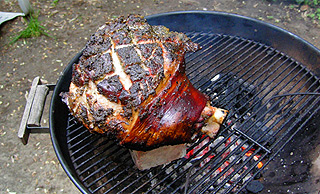For many New York foodies, gone are the days of summer hot dog and hamburger barbecues sauced with rivers of ketchup and mustard. Now, one-upmanship is the order of the day, and Weberites comb specialty butcher shops for the best prime filet, free-range chicken, and artisanally-raised pork loin, which can run $10 a pound and higher. Many of these items have the fat carefully trimmed, which is death to real barbecue. I go in the opposite direction: When I barbecue, I forage for fat. Western Beef is a huge discount supermarket that caters to immigrants who live in Chelsea's public housing projects. There, cuts of meat the size of small European cars cost less than one dollar a pound and feed families with lots of children and in-laws. Need I say that most of these cheap cuts are way fatty? As a fan of Texas barbecue, I know that plenty of fat and slow smoking in an enclosed barbecue grill with the flues carefully dampened is the way to go.

Recently, I bought a bone-in pork shoulder that weighed almost 11 pounds. Thick skin surrounded the bottom of the roast and the protruding bone (technically, I guess, the animal's thigh). The topside was a patchwork of pink meat and spatulated white fat. Normally, I would have just rubbed the thing down with kosher salt and freshly ground pepper and thrown it into the barbecue, but I hesitated a moment as I gazed at the massive hunk of meat on my kitchen counter. Then, as a tribute to the cut's importance among the Cubans, Puerto Ricans, and Dominicans who usually buy it, I made a paste of garlic, fresh oregano, flat leaf parsley, and handfuls of Sicilian sea salt. I crosshatched the top of the roast and rubbed the paste into the meat, then smoked it for eight hours at a low temperature, adjusting the shoulder on the surface of the barbecue grill carefully as the hours passed, sometimes even putting it up on a brick. Presto! Barbecued pork shoulder, pernil-style. The skin had become smoked crackling, while the surface of the roast absorbed the garlic-and-herb mixture. By osmosis, the salt in the wet rub drew the moisture out of the top layer of meat, rendering it crunchy. And, as I cut the meat on the bias, bits of the topping crumbled away and fell upon every slice, providing the best seasoning imaginable. Best of all, my under-$10 pork roast fed 20 people at a picnic that evening. And I even had plenty of meat for sandwiches the next day

